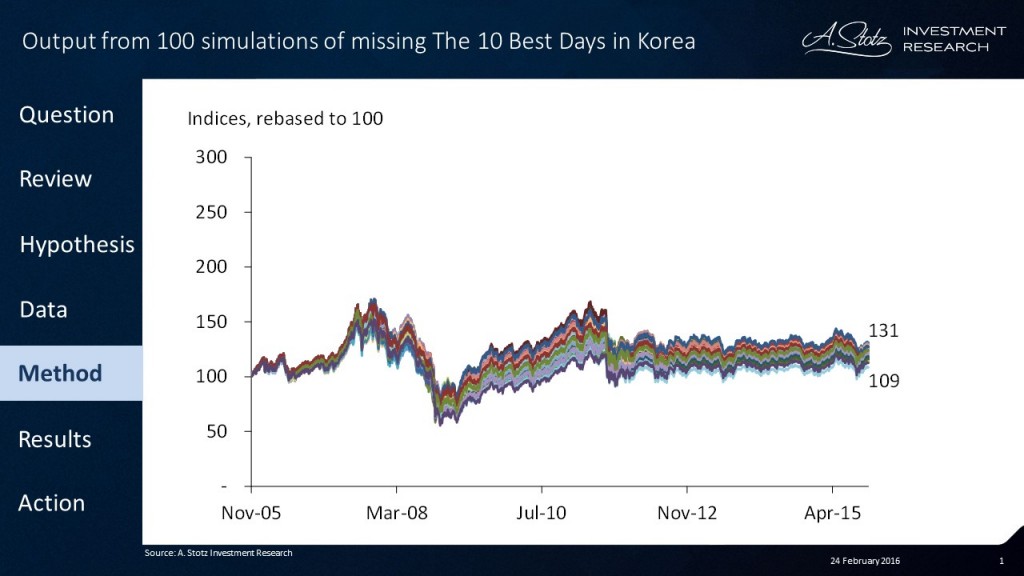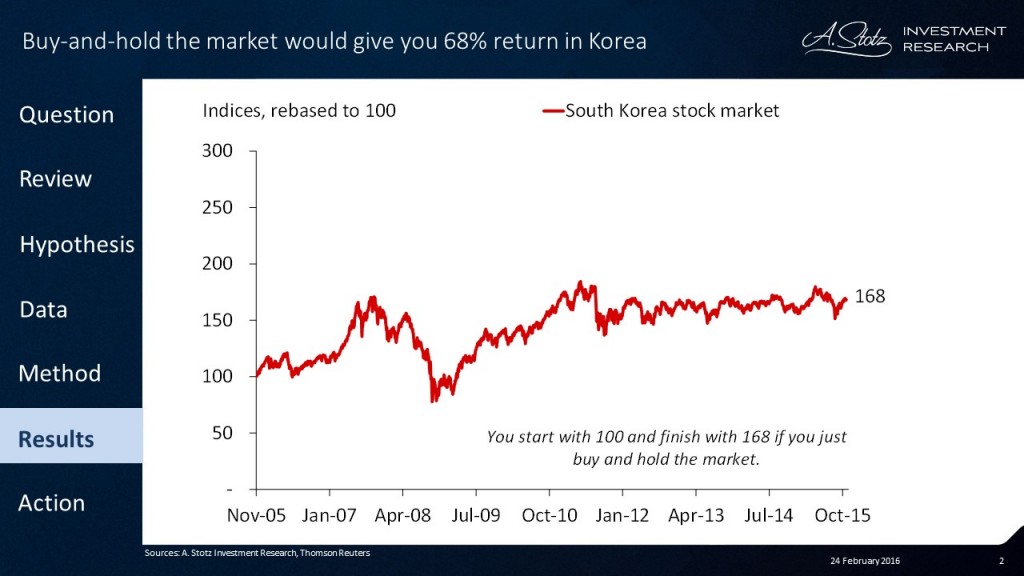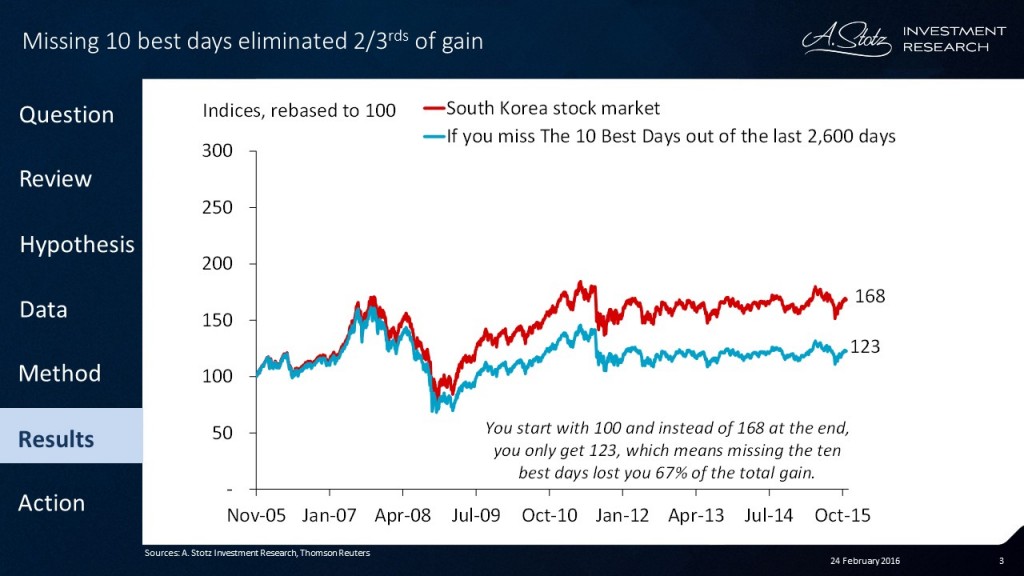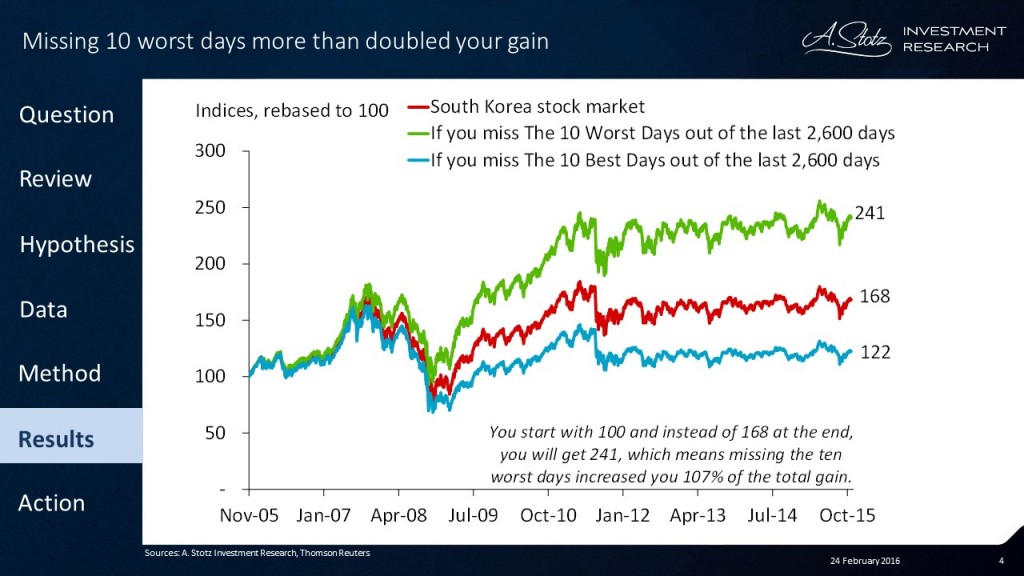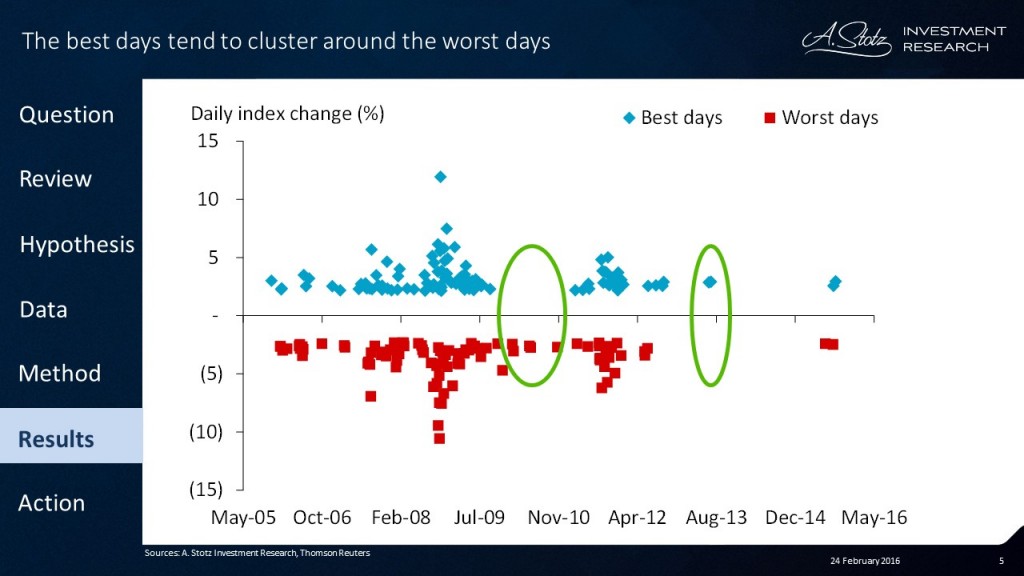The 10 Best and Worst Days: Korea
Watch the video with Andrew Stotz or read the research below.
This follows on from the work we’ve done on The 10 Best Days across the world also looking at Clustering of Best and Worst Days, and then looking at The 10 Worst Days, all of these trying to understand the impact of being out of the market on either the best or the worst days. Clustering is about trying to figure out why you would be out of the market on those days. Today, we’ll investigate the Korean market.
First of all, A. Stotz Academic-Style Research starts with us asking a question. Then we use previously conducted research to understand what we already know about our area of inquiry.
We formulate a hypothesis to test from that, and select a data set, such as “US” or “Emerging Markets”. We clean that data set as minimally as we can while still removing outliers that don’t really represent it.
Once our underlying data is ready, we apply methodology: “Here’s how we’re going to calculate and test this hypothesis.” Then we analyze the results.
From a practical perspective, we want to know, “How can this help us? What recommendations for action can we take from this, what can we learn from this to apply to our investing?”
Questions
We wanted to look into how much good or bad market timing can gain or pain you and here are the questions we had:
- What impact would missing the 10 best-return days in a 10-year period have on terminal wealth in Korea?
- What impact would missing the 10 worst-return days in a 10-year period have on terminal wealth in Korea?
- How likely is it that an investor misses the 10 best days in Korea?
Review
We looked at Seyhun’s 2003 paper. He calculated US returns over a long (1926-1993) and a medium-term (1963-1993) period of time. He found: missing the 10 best days reduced terminal wealth by 38% and avoiding the 10 worst days increased it by 92%.
In 2004, Johnson & Krueger did a study of dollar-cost averaging and market timing. Using daily returns of the S&P 500 from 1982-2001, they found that missing the 10 best days decreased annual returns by 24% and avoiding the 10 worst days in the US market enhanced annual returns by 39%. Missing both the best and worst 10 days increased annual return by about 15%.
In 2009, Estrada found that from 1900-2006, missing the 10 best days in the US market would have resulted in a 65% lower portfolio value, and missing the 10 worst days would have resulted in a 206% higher portfolio value compared to a passive buy-and-hold strategy. He also stated that the odds are stacked massively against your timing the market right, because 10 days out of the period from 1900 to 2006 account for a minuscule 0.03% of total days.
Estrada then looked at 16 Emerging markets and 110,000 daily returns. He found that missing the 10 best days would result in a 69% lower portfolio value and missing the 10 worst days would result in a 337% higher value compared to a passive buy-and-hold strategy; these extreme values are due to emerging markets being so much more volatile than developed markets such as those in the U.S.
In 2011, Faber looked at S&P 500 returns from 1928 to 2010 and saw that extreme days had the same impact. He found that 60%-80% of the best and worst days occurred in declining markets, which he defined as markets that were below their 200-day simple moving average. His research suggested that investors can time the market to some extent by being out of declining markets. So I think that insomuch as you can accurately gauge momentum turning against the market and against you, being out of it at that time could be beneficial.
Hypotheses
- Missing The 10 Best Days will significantly lower terminal wealth over a 10-year investment horizon in Korea
- Missing The 10 Worst Days will significantly increase terminal wealth over a 10-year investment horizon in Korea
- Missing the best days is likely to occur as a consequence of panic selling on the worst days in Korea
Data
We gathered the time series of daily prices of the Korean Composite Stock Price Index, the KOSPI, for the past ten years.
Method
We calculated daily percentage change. We identified the 100 best and 100 worst daily returns, and then we invested in the market, but removed 10 randomly selected days, resulting in a 0% return for those days. We repeated this process 100 times.
The probability of you actually being out of the market on the exact 10 best or worst days is highly unlikely, which is why we chose our 10-day sets randomly. To our knowledge we are the first to conduct the study in this way.
Let’s look at exactly how we executed our hypothetical trading day on the 10 days we were out of the market. We’ll call one of those random days “Day Zero”.
We sold our full portfolio position just before Day Zero. And then, right after it, reinvested at the closing price. So we missed that day entirely.
To check so the mean return is representative we run 100 simulations and identify the minimum and maximum terminal wealth. We can see a minimum of 109 and a maximum of 131 in Korea, and that the chart is almost flat. So over that 10-year period, it’s been a pretty poor performance by the Korean market.
Results
During the 10-year time period studied the if you invested in the KOSPI with a buy-and-hold strategy you would have gained a 68% return.
Now, let’s look at if you miss The 10 Best Days during our specified period.
You’d start with 100, and instead of ending up with 168, you’d only have 123, which means you missed 67% of the total gain.
If you missed The 10 Worst Days, your return would have ballooned up to 241 instead of 168, which would be more than a 100% increase in your gain.
Now, let’s ask a question about clustering. The best days, we can see, tend to be clustered around worst days.
The point of this is that if it’s clustered, it means that you could be panic selling on a worst day, and then the next day would be one of the best days.
Whereas we can see only a small number of cases where there’s little or no relationship between worst days and best days (as circled in green).
Action
- Missing only The 10 Best Days in Korea over the last 10 years seriously hurt terminal wealth. On average, you missed 67% of potential gains but could have missed as much as 87%
- Missing only The 10 Worst Days during 10 years increased your terminal wealth significantly. On average, you gained 107% more compared to a buy-and-hold portfolio
- The best days tended to cluster around the worst days. Panic selling on the worst days could therefore result in missing the best days
- Our conclusion from this is, of course, is that if you could be in during the best days and out during the worst days, it would be perfect. But you’d have to be a market-timing wizard to get the benefit of that
- Therefore, a buy-and-hold strategy has merits in Korea
Do you buy and hold or do you try to time the market? Do you invest in the Korean market? What do you think about our Academic-Style Research?
We’d love to hear from you in a comment below.
Feel free to share this article with your friends.
DISCLAIMER: This content is for information purposes only. It is not intended to be investment advice. Readers should not consider statements made by the author(s) as formal recommendations and should consult their financial advisor before making any investment decisions. While the information provided is believed to be accurate, it may include errors or inaccuracies. The author(s) cannot be held liable for any actions taken as a result of reading this article.


